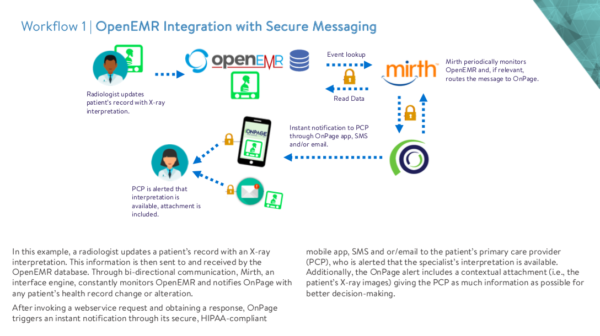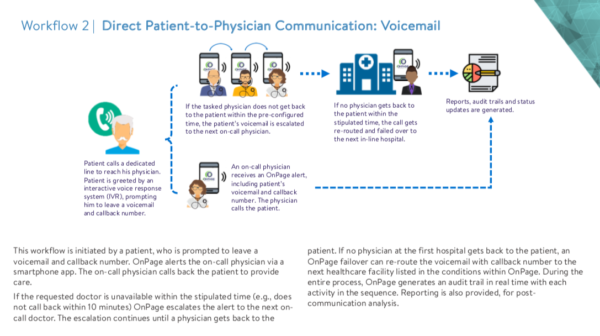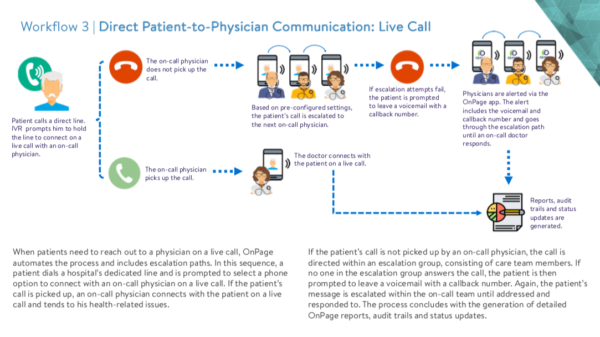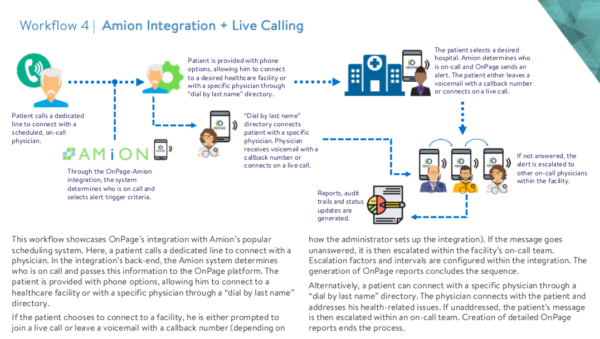Four Healthcare Workflows for Better Clinical Communications

Today’s healthcare facilities require an advanced pager replacement solution, integrating with intelligent scheduling systems and EMR solutions for better patient outcomes. This post will highlight four clinical communication workflows, showcasing how organizations can enhance and streamline physician communications.
Workflow One – EMR Integration With Secure Messaging
Electronic medical records (EMRs) store important patient information including, but not limited to, test results and clinical history. It’s crucial that healthcare organizations obtain updated EMR information, allowing care team members to provide appropriate treatment to patients.

In this sequence, we demonstrate an example of how OnPage’s integration with OpenEMR keeps primary care providers (PCPs) up-to-date regarding health record alterations. This integration can be implemented with any EMR.
The process begins when a healthcare specialist (e.g., radiologist) examines a patient and updates his record with a test result interpretation. This interpretation is automatically inputted into the OpenEMR database.
Mirth, an interface engine, will then communicate this health record change from OpenEMR to the OnPage system. After invoking a webservice request and obtaining a response, OnPage immediately triggers an alert to its HIPAA-compliant mobile app, SMS and/or email to reach the patient’s PCP.
At the end of the sequence, the PCP receives the healthcare specialist’s interpretation, alongside contextual attachments (e.g., patient’s X-ray images) for better decision-making.
Workflow Two – Direct Patient-to-Physician Communication: Voicemail
Healthcare teams can further streamline day-to-day and after-hours operations through direct patient communications. In this sequence, a patient dials a dedicated line to reach an on-call physician, leaving a voicemail with a callback number.

An on-call physician then receives an OnPage alert that includes the patient’s voicemail and callback number. The physician calls the patient and addresses his health-related concerns and issues. The sequence ends with the generation of detailed OnPage reports (i.e., audit trails and status updates).
If the tasked physician doesn’t get back to the patient within the pre-configured time, the patient’s voicemail is then escalated within a hospital’s care team. In the unlikely case that no one gets back to the patient, the patient’s call is then failed over to the next in-line healthcare facility. This ensures that patient issues are always addressed by local or nearby hospitals. Again, the sequence concludes with the creation of detailed OnPage documents.
Workflow Three – Direct Patient-to-Physician Communication: Live Call
In this sequence, fail-safe digital schedules are populated with on-call team members, and patients directly communicate with on-call physicians on a live call. If the call is answered, an on-call physician speaks with the patient, addressing his health-related concerns or issues. The sequence ends with the creation of OnPage reports.

Alternatively, if the call isn’t answered, it’s then escalated to the next on-call physician within an escalation group. If no one on the on-call group answers the call, the patient then leaves a voicemail with a callback number, providing information about his time-sensitive issues. This voicemail is escalated within the same on-call group until answered. At the end of the sequence, OnPage reports, audit trails and status updates are generated.
Workflow Four – Amion Integration and Live Calling
In this final workflow, we demonstrate how OnPage integrates with Amion’s scheduling solution.

First, the patient dials a dedicated line to reach an on-call physician. Prior to connecting to a hospital and its teams, the OnPage-Amion integration determines who’s on-call and selects alert trigger criteria.
From there, the patient connects to (1) a desired healthcare facility or (2) with a specific physician through a “dial by last name” directory.
Connecting to a Hospital: If the patient chooses the former, he’ll connect to a desired hospital on a live call or leave a voicemail with a callback number. If not answered, the facility’s escalation group will receive an OnPage alert, complemented by the patient’s voicemail. Report generation marks the conclusion of this sequence.
Connecting to a Physician: If the patient chooses the latter, he’ll connect with a desired or specific physician, ensuring that his issues are immediately addressed. Physician unavailability prompts the patient to leave a voicemail with a callback number. If still unaddressed, the patient’s voicemail is then escalated and alerted within an on-call group, consisting of clinical specialists or physicians. The sequence ends with the creation of detailed OnPage documents and reports.
As demonstrated, physicians can enhance team collaboration and improve patient experience by adopting a clinical communications solution, integrated with today’s popular scheduling and EMR systems. In this way, healthcare organizations can ensure that they provide appropriate, timely treatment during life-and-death situations.
These are just a few examples showing the flexibility of a clinical communications platform with integrations, call routing and intelligent alerting. Countless other workflows can be configured to meet the needs of today’s healthcare organizations.
Contact us for more information about OnPage’s latest healthcare integrations or reach us directly at [email protected] or at (781) 916-0040.






